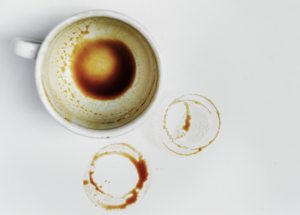
Tannin-based stains can be left behind by tea, coffee, beer, wine, and distilled spirits. The tannins those liquids contain can leave stains on cups made of porcelain or stainless steel, as well as fabrics. If you ignore those stains and do not clean them regularly, tannin can build up and cause very hard-to-remove spots on the inside of your favourite mugs. The worst part is, tannin stains may not only make your cups look unappealing but also affect the taste of your beverages.
Even though tannin-based stains are not so hard to get rid of, they should be taken care of on a regular basis. In this article, we will share some useful methods that you can use to keep your cups neat and clean.
Make sure you rinse your cup as soon as you are done using it. Avoid letting cups and mugs stay in the sink for too long. If there are visible stains when you pour the liquid out, you should get rid of them immediately.
Cleaning tannin-based stains with baking soda
- Create a cleaning paste – Put 2 tablespoons of baking soda in the stained cup and add a few drops of water (enough to create a paste).
- Scrub – Grab a damp sponge and carefully scrub the inside of your cup. Make sure you pay attention to the rim and any exterior places that may be stained as well. The baking soda will act as a wild abrasive and help loosen the stains.
- Wash the cup – Wash your cups as you usually would. You can use your dishwasher or clean them by hand. Repeat if the stains remain.
Cleaning tannin-based stains using chlorine bleach
- Prepare a cleaning solution – Fill a sink or a basin with warm water and add a tablespoon of chlorine bleach per 4 litres of water.
- Submerge the stained drinkware and allow it to sit inside for a few hours or overnight.
- Remove the drinkware from the solution and dump the bleach solution down the sink. Scrub the insides of ceramic and stainless steel coffee mugs with an abrasive sponge. Use the non-abrasive side of the sponge to clean delicate porcelain mugs and wine glasses. Before using, rinse and wash as usual.
Cleaning tannin-based stains using denture tablets
- Create a cleaning solution – FIll each cup with warm water. Add a denture tablet in each cup (for small cups, break the tablet in half and only add one of the pieces). Let the solution work for a few hours (or overnight).
- Scrub and wash – Pour the cleaning solution out. Use a damp abrasive sponge to scrub the inside of the cups. Use a non-abrasive sponge to clean delicate porcelain or wine glasses. Make sure you don’t miss any spots on the inside or outside of the mugs. Wash by hand or place the drinkware in the dishwasher.
- Dampen a melamine sponge and gently scrub the interior and exterior of the cup.
Don’t use a melamine sponge on delicate wine glasses or drinkware with metallic or hand-painted ornamentation. It might scrape or remove the decorations. - Fill up the cups with a warm 1:1 solution of water and white vinegar. You can also fill a sink or a bucket with the same solution and place your dirty cups in it. Let them soak for about 30 minutes in any case.
- Scrub well – Grab a sponge and scrub the inside and outside of your cups. On ceramic and stainless steel mugs, use the abrasive side, whereas on delicate wine glasses and porcelain cups, use the non-abrasive side.
- Use a commercial store-bought powder or a homemade one. Sprinkle it on the inside of the cup and scrub with a damp sponge. Use a gentle scouring powder and avoid harsh products.
- Make sure you scrub the rim and exterior of the cup and wash the cups very well after cleaning them (especially if you are using a commercial product that contains a lot of chemicals). If you make your own powder, use ingredients that are biodegradable and safe for your health.
- After each use, rinse or wash drinkware to eliminate sediment or small amounts of liquid that can cause stains.
- Scrub the interior of travel mugs or tall, narrow drinkware that is difficult to clean by hand with a soft-bristled bottle brush.
- As soon as you notice any discoloration or stains, use one of the stain removal tips.
- Never leave your coffee/tea mug half full in the sink. Rinse it with water, then wash it thoroughly.
- Cleaning tannin-based stains using a melamine sponge
Cleaning tannin-based stains using distilled white vinegar
Cleaning tannin-based stains using scouring powder
Do not use scouring powder on delicate wine glasses or cups with decorations that are metallic or hand-painted. It may damage or remove them.
How to keep tannin-based stains from forming on drinkware:
